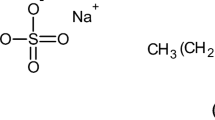Abstract
Laundry surfactants are usually mixtures of ionic and nonionic detergents that exhibit a complex phase behavior. Here the ternary phase behavior of an isotropic and a liquid crystalline (LC) surfactant mixture has been examined in water/solvent systems. The size of the LC area in the ternary phase diagram was correlated to solvent parameters including the dielectric constant and the Gordon cohesiveness parameter. The Gordon parameter was found to have a linear relationship with the amount of solvent needed to go from an LC to an isotropic state over a wide range of solvents from polar to apolar. For solvents in which no surfactant aggregation (micellar or inverted micellar) is expected, the size of the LC area is linear with the reciprocal of the dielectric constant of the solvent. On diluting practical detergent liquids with water, a large LC area can be avoided by using solvents with a relatively low dielectric constant and with a relatively low molecular weight.
The aggregated state of the surfactant mixtures in the isotropic regions of the phase diagram was studied using the solvatochromic fluorescent probe Nile Red. In the water corner of the phase diagram, the surfactants are aggregated into micelles. In strongly polar solvents, such as glycerol, ethylene glycol, formamide, and ethanolamine, the surfactants are also aggregated into micelles. In somewhat less polar solvents, such as methanol, ethanol, and t-butanol, the surfactant molecules are randomly distributed. In the surfactant-rich corner of the phase diagram of the isotropic mixture, the surfactant forms inverted micelles. An inverted micelle-to-micelle transition could be observed on dilution in ethylene glycol as a discontinuity in the trend of the Nile Red fluorescence maxima.
Similar content being viewed by others
Abbreviations
- CMC:
-
critical micelle concentration
- LAS:
-
linear alkylbenzene sulfonic acid
- LC:
-
liquid crystalline
- MEA:
-
monoethanolamine
- λmax :
-
Nile Red maximum emission wave length
References
Mitchell, D.J., G.J.T. Tiddy, L. Waring, T. Bostock, and M.P. McDonald, Phase-Behavior of Polyoxyethylene Surfactants with Water—Mesophase Structures and Partial Miscibility (Cloud Points), J. Chem. Soc., Faraday Trans. 1 79:975–1000 (1983).
Madelmont, C., and R. Perron, Study of Influence of Chain-Length on Some Aspects of Soap-Water Diagrams, Colloid Polym. Sci. 254:581–595 (1976).
Tiddy, G.J.T., Surfactant-Water Liquid-Crystal Phases, Phys. Rep.-Rev. Sec. Phys. Lett. 57:2–46 (1980).
Ward, A.J.L., and C. Du Reau, Surfactant Association in Nonaqueous Media, in Surface and Colloid Science, edited by E. Matijevic, Plenum Press, New York, 1993, p. 153.
Warnheim, T., Aggregation of Surfactants in Nonaqueous, Polar Solvents, Curr. Opin. Coll. Interf. Sci. 2:472–477 (1997).
Martino, A., and E.W. Kaler, The Stability of Lamellar Phases in Water, Propylene Glycol, and Surfactant Mixtures, Colloid Surf. A-Physicochem. Eng. Asp. 99:91–99 (1995).
Shinoda, K., A New Concept “Ideal Organized Solution”: Comparison of Random Mixing Solutions and Ideal Organized Solution, Langmuir 7:2877–2880 (1991).
Ravey, J.C., M. Buzier, and C. Picot, Micellar Structures of Nonionic Surfactants in Apolar Media, J. Colloid Interface Sci. 97:9–25 (1984).
Greenspan, P., and S.D. Fowler, Spectrofluorometric Studies of the Lipid Probe, Nile Red, J. Lipid Res. 26:781–789 (1985).
Stuart, M.C.A., J.C. van de Pas, and J.B.F.N. Engberts, The Use of Nile Red to Monitor the Aggregation Behavior in Ternary Surfactant-Water-Organic Solvent System, J. Phys. Org. Chem. 18:929–934 (2005).
Hungerford, G., E.M.S. Castanheira, M.E.C.D. Oliveira, M.D. Miguel, and H. Burrows, Monitoring Ternary Systems of C12EO5/Water/Tetradecane via the Fluorescence of Solvatochromic Probes, J. Phys. Chem. B 106:4061–4069 (2002).
Oliveira, M.E.C.D., G. Hungerford, M.D. Miguel, and H.D. Burrows, Solvatochromic Fluorescent Probes in Bicontinuous Microemulsions, J. Mol. Struct. 563:443–447 (2001).
Deye, J.F., T.A. Berger, and A.G. Anderson, Nile Red as a Solvatochromic Dye for Measuring Solvent Strength in Normal Liquids and Mixtures of Normal Liquids with Supercritical and Near Critical Fluids, Anal. Chem. 62:615–622 (1990).
Datta, A., D. Mandal, S.K. Pal, and K. Bhattacharyya, Intramolecular Charge Transfer Processes in Confined systems. Nile Red in Reverse Micelles, J. Phys. Chem. B 101:10221–10225 (1997).
Evans, D.F., and D.D. Miller, Organized Solutions and Their Manifestations in Polar Solvents, in Organized Solutions. Surfactants in Science and Technology. Surfactant Science Series, edited by S.E. Friberg and B. Lindman, Marcel Dekker, New York, 1992, Vol. 44, p. 33.
Gordon, J.E., The Organic Chemistry of Electrolyte Solutions, Wiley Interscience, New York, 1975.
Hildebrand, J.H., and Scott R.L., Surface Phenomena, in The Solubility of Nonelectrolytes, edited by J.H. Hildebrand and R.L. Scott, Dover Publications, New York, 1964, p. 397.
Barton, A.F.M., Solubility Parameters, Chem. Rev. 75:731–753 (1975).
Kamlet, M.J., J.L. Abboud, and R.W. Taft, Solvatochromic Comparison Method 6. Pi-Star Scale of Solvent Polarities, J. Am. Chem. Soc. 99:6027–6038 (1977).
Gardon, J.L., Critical Review of Concepts Common to Cohesive Energy Density, Surface Tension, Tensile Strength, Heat of Mixing, Interfacial Tension, and Butt Joint Strength, J. Colloid Interface Sci. 59:582–596 (1977).
Schonhorn, H., Theoretical Relationship Between Surface Tension and Cohesive Energy Density, J. Chem. Phys. 43:2041–2043 (1965).
Aramaki, K., U. Olsson, Y. Yamaguchi, and H. Kunieda, Effect of Water-Soluble Alcohols on Surfactant Aggregation in the C12EO8 system, Langmuir 15:6226–6232 (1999).
Ramadan, M.S., D.F. Evans, R. Lumry, and S. Philson, Micelle Formation in Hydrazine-Water Mixtures, J. Phys. Chem. 89:3405–3408 (1985).
Jones, P., E. Wynjones, and G.J.T. Tiddy, Kinetic and Equilibrium Studies Associated with the Aggregation of Nonionic Surfactants in Nonpolar Solvents, J. Chem. Soc., Faraday Trans. 1 83:2735–2749 (1987).
Author information
Authors and Affiliations
Corresponding author
About this article
Cite this article
Stuart, M.C.A., Van de Pas, J.C. & Engberts, J.B.F.N. Phase behavior of laundry surfactants in polar solvents. J Surfact Deterg 9, 153–160 (2006). https://doi.org/10.1007/s11743-006-0385-8
Received:
Accepted:
Issue Date:
DOI: https://doi.org/10.1007/s11743-006-0385-8




